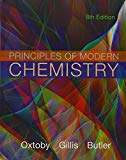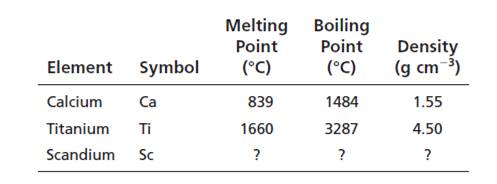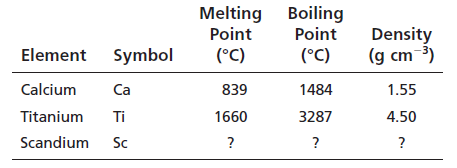
Before the element scandium was discovered in 1879, it was known as “eka-boron.” Predict the properties of scandium from averages of the corresponding properties of its neighboring elements in the periodic table. Compare your predictions with the observed values in Appendix F.

Interpretation:
The properties of scandium should be determined from the averages of the properties of neighbouring elements in the periodic table and predictions should be compared with the observed values in Appendix F.
Concept introduction:
The periodic table contains periods and groups. There are 18 groups and 7 periods in the periodic table. The vertical columns are known as groups and horizontal rows are known as periods.
The numbering of periods is done as 1 to 7 from top to bottom and groups are named as 1A, 2A, 3B to 8B, 1B, 2B, 3A to 8A from left to right where A represents representative elements and B represents transition elements. Elements in the same family have similar chemical and physical properties. In the periodic table, elements are classified as metals, non-metals or metalloids.
Answer to Problem 1P
Calculated values of Scandium are:
Melting point = 1250oC
Boiling point = 2386oC
Density = 3.02 g/cm3
The observed values and calculated values are nearer.
Explanation of Solution
Given information:

Scandium belongs to group 3 and period 4.The electronic configuration of scandium is:
Melting point is calculated as =
= 1249.5oC
Boiling point is calculated as =
= 2386oC
Density is calculated as =
=
Now, from Appendix F:
Melting point of scandium = 1541oC
Boiling point of scandium = 2386oC
Density of scandium = 2.99 g/cm3
According to the calculated value and observed values, the physical properties are nearer but not exactly the same.
Want to see more full solutions like this?
Chapter 3 Solutions
Bundle: Principles Of Modern Chemistry, 8th + Owlv2, 4 Terms (24 Months) Printed Access Card
- Look in Appendix D and compare the electron configurations shown there with the fusion enthalpies for the metals shown in Table 9.7. Is there any correlation between these configurations and this property? Does strength of attraction among metal atoms correlate with number of valence electrons? Explain your answers.arrow_forwardWithout consulting any tables, arrange the following substances in order and explain your choice of order: (a) Mg2+,Ar,Br,Ca2+ in order of increasing radius (b) Na, Na+ , O, Ne in order of increasing ionization energy (c) H, F, Al, O in order of increasing electronegativityarrow_forwardAccount for the fact that the line that separates the metals from the nonmetals on the periodic table is diagonal downward to the right instead of horizontal or vertical.arrow_forward
- Explain how the thermodynamics of ionic crystal formation can be used to determine electron affinitiesarrow_forward(a) Account for formation of the following series of oxidesin terms of the electron configurations of the elementsand the discussion of ionic compounds in Section 2.7:K2O, CaO, Sc2O3, TiO2, V2O5, CrO3. (b) Name these oxides.(c) Consider the metal oxides whose enthalpies of formation(in kJ mol - 1) are listed here.Oxide K2O1s2 CaO1s2 TiO21s2 V2O51s2ΔHf° -363.2 -635.1 -938.7 -1550.6Calculate the enthalpy changes in the following general reactionfor each case:MnOm1s2 + H21g2¡nM1s2 + mH2O1g2(You will need to write the balanced equation for each caseand then compute ΔH°.) (d) Based on the data given, estimatea value of ΔHf° for Sc2O31s2.arrow_forwardWhat is the periodic trend in ionic size for the cations of these alkaline earth elements: Mg2+, Ca2+, Sr2+, Ba2+?arrow_forward
- Group the electronic configurations of neutral elements in sets according to those you would expect to show similar chemical propertiesarrow_forwardThe Properties, Reactions and Applications of Oxygen Give its symbol, atomic structure, its electronic configuration, the elemental state of its two allotropes, (including a definition of the term allotrope). The discovery of dioxygen and the means of production with a balanced chemical equation. A comparison of the elemental state of oxygen to that of sulfur.arrow_forwardIf the exact outer limit of an isolated atom cannot be meas-ured, what criterion can we use to determine atomic radii? What is the difference between a covalent radius and a metallic radius?arrow_forward
- What is the significance of knowing the properties of elements (periodic table) in the food industry and medicine?arrow_forwardPartial (valence-level) electron configurations for four different ions are shown below: Identify the elements from which the ions are derived, and write the formula of the oxide each ion forms.arrow_forward
 Principles of Modern ChemistryChemistryISBN:9781305079113Author:David W. Oxtoby, H. Pat Gillis, Laurie J. ButlerPublisher:Cengage Learning
Principles of Modern ChemistryChemistryISBN:9781305079113Author:David W. Oxtoby, H. Pat Gillis, Laurie J. ButlerPublisher:Cengage Learning Chemistry: Principles and PracticeChemistryISBN:9780534420123Author:Daniel L. Reger, Scott R. Goode, David W. Ball, Edward MercerPublisher:Cengage Learning
Chemistry: Principles and PracticeChemistryISBN:9780534420123Author:Daniel L. Reger, Scott R. Goode, David W. Ball, Edward MercerPublisher:Cengage Learning Chemistry: The Molecular ScienceChemistryISBN:9781285199047Author:John W. Moore, Conrad L. StanitskiPublisher:Cengage Learning
Chemistry: The Molecular ScienceChemistryISBN:9781285199047Author:John W. Moore, Conrad L. StanitskiPublisher:Cengage Learning ChemistryChemistryISBN:9781305957404Author:Steven S. Zumdahl, Susan A. Zumdahl, Donald J. DeCostePublisher:Cengage Learning
ChemistryChemistryISBN:9781305957404Author:Steven S. Zumdahl, Susan A. Zumdahl, Donald J. DeCostePublisher:Cengage Learning
 Chemistry: An Atoms First ApproachChemistryISBN:9781305079243Author:Steven S. Zumdahl, Susan A. ZumdahlPublisher:Cengage Learning
Chemistry: An Atoms First ApproachChemistryISBN:9781305079243Author:Steven S. Zumdahl, Susan A. ZumdahlPublisher:Cengage Learning





